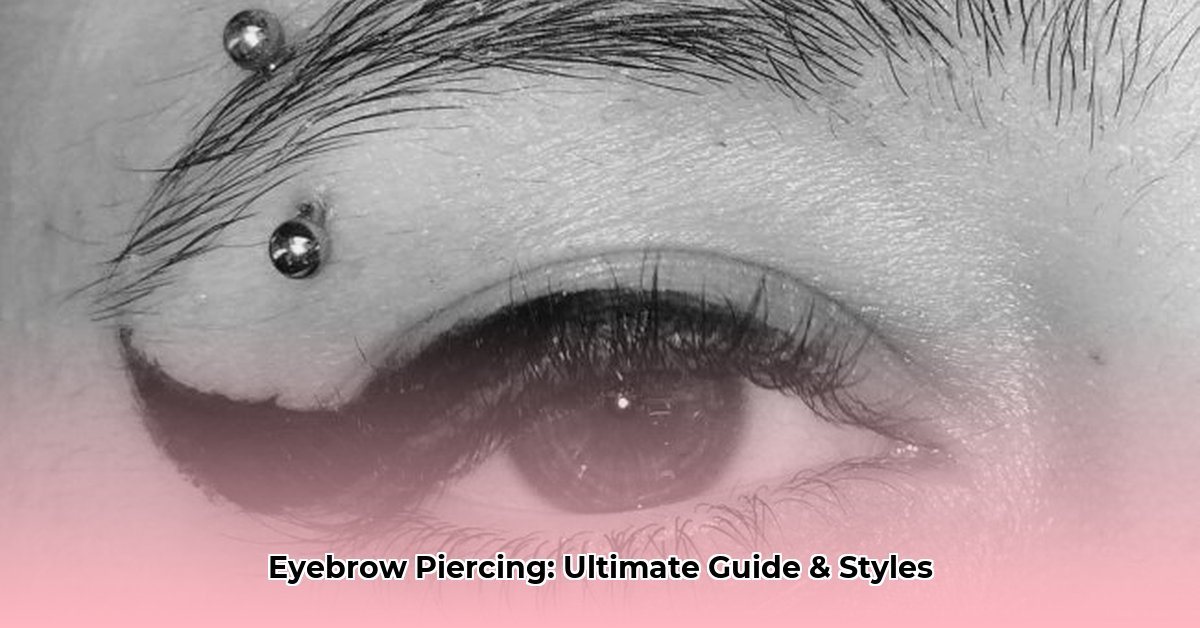Thinking about getting your eyebrows pierced? This guide will walk you through everything you need to know, from picking the perfect style to keeping it healthy and looking great. We’ll explore the diverse array of eyebrow piercing options and provide insights on selecting the one that complements your facial features. Plus, you’ll learn about selecting a safe piercer, picking the right jewelry, and avoiding common problems.
Eyebrow Piercing: A Comprehensive Guide
Considering an eyebrow piercing is an exciting way to express your individuality. This comprehensive guide covers various styles, aftercare practices, and potential complications, ensuring you’re well-prepared for a positive and informed decision.
Exploring Eyebrow Piercing Styles
Eyebrow piercings have expanded beyond the classic vertical placement. Each style offers a unique aesthetic and requires specific care for optimal healing.
- Vertical Eyebrow Piercing: The most common type, it runs vertically through the eyebrow, usually following the natural curve. It’s typically placed on the outer third of the eyebrow and uses a curved barbell.
- Horizontal Eyebrow Piercing: Placed horizontally above or below the eyebrow, this piercing offers a modern look. It is more prone to rejection and often requires a surface bar.
- Anti-Eyebrow Piercing: Situated on the cheekbone below the eye, this piercing creates a unique and subtle adornment. It’s also a surface piercing and benefits from a surface bar.
- Bridge Piercing (Erl): While not strictly an eyebrow piercing, it’s placed on the bridge of the nose between the eyebrows. Anatomy is important; it requires enough skin to support the jewelry, typically a straight or curved barbell.
- Multiple Eyebrow Piercings: Several piercings are placed along the eyebrow, allowing for creative and personalized arrangements. This could be multiple vertical, horizontal, or a combination of both.
- Spiral Eyebrow Piercing: This involves multiple piercings connected by a spiral-shaped piece of jewelry. It requires careful placement and a skilled piercer.
- T-Shaped Eyebrow Piercing: A combination of vertical and horizontal piercings that intersect to form a “T” shape. This is a more complex piercing that requires an experienced piercer and careful aftercare.
- Inner Eyebrow Piercing: A vertical piercing placed closer to the nose. Due to the proximity to nerves, a highly qualified piercer is essential.
- Center Brow Piercing: A vertical piercing positioned in the center of the eyebrow. Often done in pairs for a symmetrical look.
- Forehead Dermal Piercing: While not an eyebrow piercing, this is a single piercing placed in the center of the forehead, using a dermal anchor under the skin.
When considering unique or intricate piercing styles, consulting with a skilled technician is critical due to the increased risks of migration, rejection, and improper healing.
Factors to Consider When Choosing Your Piercing
Selecting the ideal eyebrow piercing depends on your personal style, facial features, and brow shape. Consider these factors:
- Brow Thickness and Shape: Thicker eyebrows generally offer more stability. The shape will influence the placement to complement your features.
- Placement and Anatomy: Inner placements closer to the nose carry a greater risk of nerve damage, emphasizing the need for an experienced piercer. A consultation will determine if your brow ridge is prominent enough for the desired piercing.
- Pain Tolerance: Eyebrow piercings are generally considered low on the pain scale, but multiple piercings may increase discomfort.
- Lifestyle: Consider your activities and occupation. Piercings can be affected by sports, helmets, or workplace hazards.
- Aesthetic Vision: Research photos to visualize how different piercings will complement your features. Seek advice for suitable placements.
Jewelry Selection
The right jewelry enhances your piercing and supports healing:
- Curved Barbells: Most suitable for vertical piercings. The curve follows the natural contour of the eyebrow.
- Surface Bars: Designed for horizontal and anti-eyebrow piercings. They distribute pressure evenly across the surface.
- Straight Barbells: Used for bridge piercings.
- Captive Bead Rings: Can be used after initial healing for vertical piercings.
- Dermal Anchors: Used for forehead dermal piercings.
Opt for biocompatible materials like implant-grade titanium, surgical steel, or 14k/18k gold to minimize irritation or allergic reactions. Consult your piercer for the best option based on your skin sensitivity and piercing style.
Aftercare Essentials
Proper aftercare is crucial for healing and preventing complications:
- Cleanse: Gently cleanse your piercing twice daily with a sterile saline solution.
- Hands Off: Avoid touching or adjusting your piercing to prevent bacterial contamination.
- Avoid Rotation: It’s now generally advised not to rotate the jewelry during healing, as this can cause irritation.
- Makeup and Cosmetics: Keep makeup, lotions, and hair products away from the piercing until fully healed.
- Shower with Care: Avoid direct water spray on the piercing to minimize pressure and contamination.
- Dry Thoroughly: Gently pat the area dry with a clean paper towel after cleaning or showering.
- Avoid Irritants: Stay away from harsh chemicals, fragranced products, and swimming pools during healing.
- Monitor: Watch for signs of infection like redness, swelling, pain, or discharge, and consult your piercer or a doctor if they occur.
Potential Risks and Complications
While generally safe, potential complications can occur:
- Migration: Gradual movement of the piercing from its original location. More common with surface piercings.
- Rejection: The body expelling the piercing. Can lead to scarring if not addressed promptly.
- Infection: Poor aftercare or unsanitary conditions increase infection risk.
- Scarring: Keloid formation or hypertrophic scarring can occur.
- Nerve Damage: Rare, but more likely with inner eyebrow piercings.
- Allergic Reactions: Can occur with lower-quality jewelry.
Finding the Right Piercer
Selecting a reputable and experienced piercer is critical for a safe and successful piercing experience. Look for these qualities:
- Experience: A portfolio demonstrating extensive experience with various eyebrow piercings.
- Cleanliness: A spotless studio that adheres to strict sterilization protocols, including using an autoclave.
- Licensing and Certification: Proper credentials demonstrating a commitment to safety and industry standards.
- Reputation: Positive reviews and testimonials from previous clients.
- Consultation: A thorough consultation to discuss your anatomy, placement options, and aftercare instructions.
Don’t hesitate to ask questions and express any concerns. A knowledgeable piercer will guide you and help you make informed decisions.
Minimizing Eyebrow Piercing Rejection Risk
Eyebrow piercings, as surface piercings, are susceptible to rejection. Understanding and mitigating this risk is crucial for long-term success. Key strategies include choosing a skilled piercer, selecting biocompatible jewelry, and practicing diligent aftercare.
Understanding Eyebrow Piercing Rejection
The body may recognize a piercing as a foreign object and attempt to expel it, leading to rejection. Recognizing the causes and taking preventive measures can help minimize this risk.
Piercer Expertise and Jewelry Choice
Selecting a reputable piercer is the first step. Look for experience, a clean studio, and a commitment to proper sterilization. A skilled piercer will use correct techniques and place the jewelry at the right depth and angle.
Jewelry material also matters. Implant-grade titanium is often recommended due to its biocompatibility, which reduces irritation and allergic reactions that can trigger rejection.
Aftercare Strategies
Diligent aftercare is essential for preventing rejection:
- Cleanse Gently: Clean the piercing twice daily with a sterile saline solution, avoiding harsh soaps or chemicals.
- Avoid Touching: Resist touching or playing with the piercing, as this can introduce bacteria and cause irritation.
- Pat Dry: Gently pat the area dry with a clean paper towel after cleaning.
- Avoid Pressure: Minimize pressure on the piercing by avoiding sleeping on it or wearing tight clothing that rubs against it.
- Healthy Lifestyle: Maintain a healthy lifestyle by eating a balanced diet and staying hydrated to support your body’s healing process.
Recognizing Signs of Rejection: Act Early
Early detection is critical for preventing further complications. Signs of rejection include:
- Increased pain, redness, and swelling around the piercing site.
- Thinning of the skin around the jewelry.
- Visible migration of the jewelry closer to the surface of the skin.
- Enlarged piercing hole.
- Jewelry feeling looser than usual.
Promptly consult your piercer if you notice any of these signs. They may recommend removing the piercing to minimize scarring.
- Bento Box Trays Streamline Restaurant Meal Presentation and Transport - December 13, 2025
- Plastic Bento Boxes Face Scrutiny Over Sustainability Impacts - December 11, 2025
- Bento Tray Revolutionizes Organized Meal Transport and Presentation - December 10, 2025










